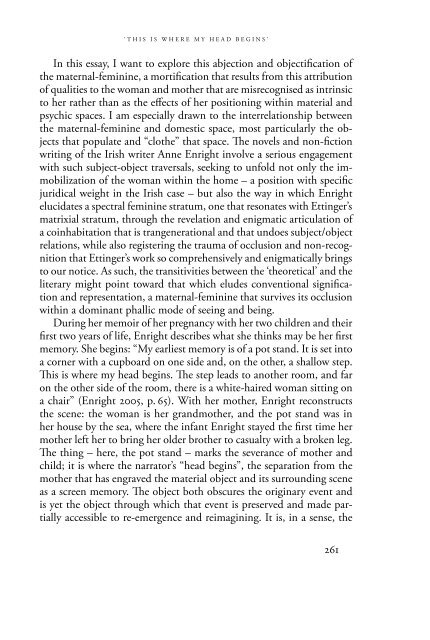Bodily proximity - Poligrafi.si
Bodily proximity - Poligrafi.si
Bodily proximity - Poligrafi.si
Create successful ePaper yourself
Turn your PDF publications into a flip-book with our unique Google optimized e-Paper software.
‘THIS IS WHERE MY HEAD BEGINS’<br />
In this essay, I want to explore this abjection and objectification of<br />
the maternal-feminine, a mortification that results from this attribution<br />
of qualities to the woman and mother that are misrecognised as intrin<strong>si</strong>c<br />
to her rather than as the effects of her po<strong>si</strong>tioning within material and<br />
psychic spaces. I am especially drawn to the interrelationship between<br />
the maternal-feminine and domestic space, most particularly the objects<br />
that populate and “clothe” that space. The novels and non-fiction<br />
w riting of the Irish writer Anne Enright involve a serious engagement<br />
with such subject-object traversals, seeking to unfold not only the immobilization<br />
of the woman within the home – a po<strong>si</strong>tion with specific<br />
juridical weight in the Irish case – but also the way in which Enright<br />
elucidates a spectral feminine stratum, one that resonates with Ettinger’s<br />
matrixial stratum, through the revelation and enigmatic articulation of<br />
a coinhabitation that is trangenerational and that undoes subject/object<br />
relations, while also registering the trauma of occlu<strong>si</strong>on and non-recognition<br />
that Ettinger’s work so comprehen<strong>si</strong>vely and enigmatically brings<br />
to our notice. As such, the tran<strong>si</strong>tivities between the ‘theoretical’ and the<br />
literary might point toward that which eludes conventional <strong>si</strong>gnification<br />
and representation, a maternal-feminine that survives its occlu<strong>si</strong>on<br />
within a dominant phallic mode of seeing and being.<br />
During her memoir of her pregnancy with her two children and their<br />
first two years of life, Enright describes what she thinks may be her first<br />
memory. She begins: “My earliest memory is of a pot stand. It is set into<br />
a corner with a cupboard on one <strong>si</strong>de and, on the other, a shallow step.<br />
This is where my head begins. The step leads to another room, and far<br />
on the other <strong>si</strong>de of the room, there is a white-haired woman <strong>si</strong>tting on<br />
a chair” (Enright 2005, p. 65). With her mother, Enright reconstructs<br />
the scene: the woman is her grandmother, and the pot stand was in<br />
her house by the sea, where the infant Enright stayed the first time her<br />
mother left her to bring her older brother to casualty with a broken leg.<br />
The thing – here, the pot stand – marks the severance of mother and<br />
child; it is where the narrator’s “head begins”, the separation from the<br />
mother that has engraved the material object and its surrounding scene<br />
as a screen memory. The object both obscures the originary event and<br />
is yet the object through which that event is preserved and made partially<br />
acces<strong>si</strong>ble to re-emergence and reimagining. It is, in a sense, the<br />
261


